Maybe you like vintage-style t-shirts and jeans. Maybe you just like the softer, less coarse feel of well-worn clothing against your skin. Either way, you probably find yourself wondering how to fade clothes and get that classic vintage look and softened texture in your wardrobe.
The best way to fade new clothing is to wash it multiple times to relax the fibers inside the fabric. Other methods include exposing the garment to sunlight for prolonged periods or removing dye by bleaching. All-natural products used to fade clothes include baking soda, salt, lemon juice, and vinegar.
In this article, you will learn eight simple methods for fading clothes. You will find out how to fade clothes without bleach. Finally, you will get tips on how to fade brightly colored clothes, too!
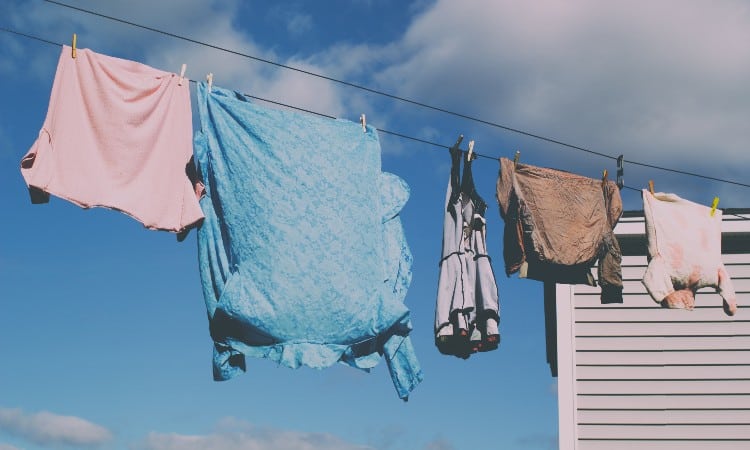
What Makes Laundry Fade?
Heat and friction can cause your laundry to bleed dye or appear faded. Using a hot water washing machine cycle, selecting the heavy wash setting instead of delicate, and putting your clothes in the dryer can cause them to fade.
Some clothes remain dye fast basically no matter what you do, but others will leak dye everywhere the first few times you wash them! New jeans, in particular, have a bad reputation for dye explosions. Hot water will make these types of garments fade much faster than cold water.
If you want to avoid fading your laundry, always use a cold water wash. Choose a delicate or normal washing machine cycle, too. Finally, air-dry your clothes instead of putting them in the dryer. The tumbling action of the dryer creates a lot of friction on the fibers in your garments, causing them to look rough and fade on the surface of the clothing.
Some types of material should not even go in the laundry, such as silk or wool. Make sure you read the manufacturer’s care label inside your garment before putting it in the washing machine if you want to keep your clothes in good condition.
Of course, sometimes you want to fade your clothes! In that case, you should learn the best ways to fade clothes to that nice vintage hue without actually damaging the fabric.
How to Fade Clothes Without Bleach
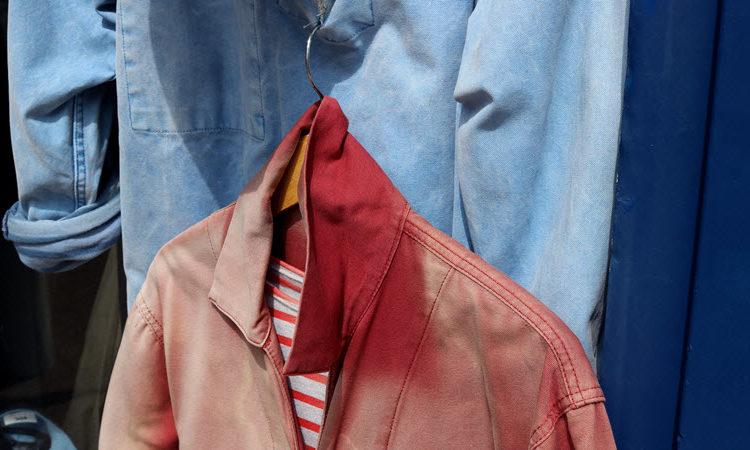
You can use many different methods to fade your clothing without using a strong chemical like bleach, including simply using the washing machine or applying at-home remedies such as sunlight or lemon juice.
1. Washer
While washing your clothes according to the manufacturer’s instructions should not cause them to fade, washing them in hot water will create a faded appearance over time.
The benefit to this method is that you can choose to apply it over time and just wash your clothes as they need cleaning. This means you don’t waste water, too! But this process does typically take repeated washings, usually at least five or six cycles, before you see results.
For that reason, you may want to just get it over with and wash your clothing again and again right away to get the look you want.
The downside to this method is that the fabric in your clothing will wear out during this repeated washing process.
To fade your clothes in the washing machine:
- Look at the settings on your washing machine. Typically you will find options for how intense you want the wash to get. Select heavy or extended wash if you have that option.
- Now, look at the temperature controls. Set the water temperature to hot.
- Place the garment you want to fade in the machine. Do not add other clothing unless you want to risk spreading dye around to other garments!
- Add a normal amount of detergent.
- Run the machine all the way through.
- To protect the material of your garment as much as possible, you should allow it to air dry after that heavy-duty wash cycle. However, you can move on to the dryer method at this point to speed up the fading.
- Either way, you will typically need to repeat this process several times to see extreme fading.
2. Dryer
The tumbling action that happens in modern dryers creates a lot of friction on the surface of your clothes, roughing up the surface fibers so that they may appear faded over time.
Placing clothing in a dryer on high heat can also cause the fibers inside the material to relax, making the garment feel softer to the touch.
As a word of warning, you should know upfront that putting pretty much any type of material in the dryer will wear out the fabric. Yes, the dryer is convenient, and it does create that soft texture that feels so nice, but air drying will prolong the lifespan of your clothes by years more than using a dryer will.
Plus, the dryer will shrink some types of fabric. If your care label says to air-dry, you should not use this method!
You can achieve a faded surface on your clothing by placing it in the dryer after washing it. This is not a method per se; all you have to do is put the garment inside the dryer and turn the dryer on! The tumbling movement on any setting will cause friction and some fading.
Just know that the dryer can damage some types of material, especially anything that contains spandex.
3. Sun Fading
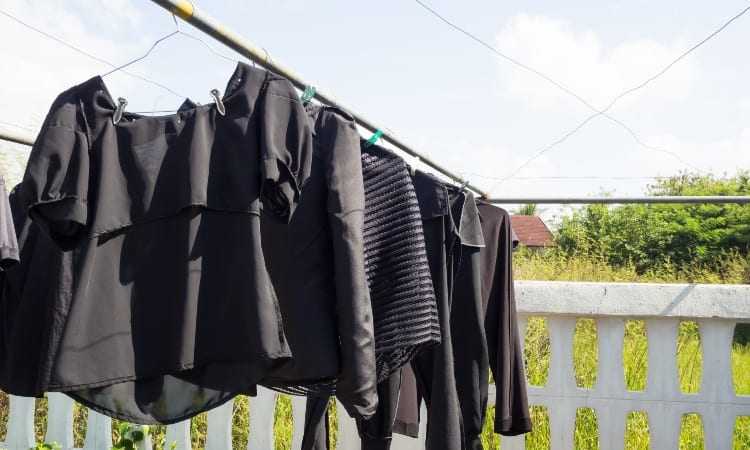
On the other end of the spectrum, you can choose to go all-natural and fade your clothes outside in the sunlight!
The downside to sun fading is that you do not get instant results. You generally have to layout your garment for at least a couple of sunny days before you see fading.
Other potential issues include clothing treated with UV-resistant chemicals. You see this often in synthetic sportswear, such as running tank tops or t-shirts. These clothes should not fade, no matter how long you leave them out!
Natural fabric will fade much more quickly than synthetic fabric, as well. So check the label inside your garment to find out what type of material you have to deal with!
Sun fading will create some of the prettiest, most vintage-looking hues in your clothes, but you do need to keep a sharp eye on the process as you go. You don’t want the fade to splotch one area of the garment and not another because the sun moved during the day, for example!
- For the quickest fading process, wash your clothes in your washing machine on a hot water setting as a first step. If you want to protect your clothes, skip this step and just take the dry garment outside.
- Find a nice sunny spot outside. If necessary, you can also use a spot behind a sunny window inside, but the direction of the sunlight will shift during the day, making this a less ideal option.
- Spread out a clean white towel or bedsheet and place the garment on top.
- Leave it for several hours. You will want to check on the garment every couple of hours to make sure that it remains in direct sunlight and adjust the garment so that all parts get similar sun exposure.
- If you want an even fade on the front and back, you will have to repeat the process for the other side of the garment.
The main thing to remember if you try the sunlight method is that you need to monitor the situation to see how much a garment fades. Sunlight can and will eventually fade most garments, even black jeans!
4. Baking Soda
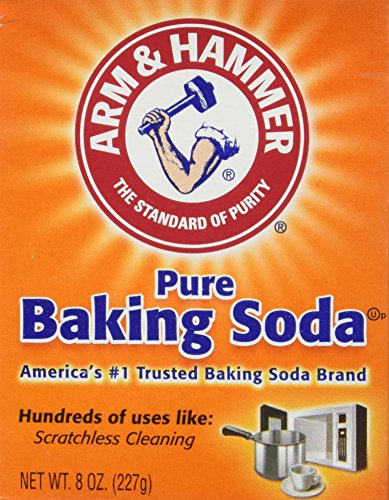 Under some circumstances, adding baking soda to the wash can speed up the fading process in your clothes.
Under some circumstances, adding baking soda to the wash can speed up the fading process in your clothes.
Laundry experts offer mixed opinions on what effect baking soda has on clothing. Some insist that you can use baking soda in place of laundry detergent and that it brightens white clothes and does not fade colors at all. Others suggest that baking soda rubs on the fibers of your garments, causing them to roughen and fade.
Science does back up the fact that baking soda will damage some fabrics. For that reason, you should not try this method on a garment that contains nylon, elastane, wool, or silk.
The most effective way to use baking soda is to combine it with salt, as you will see in the salt method below. That said, you can achieve more gentle results with baking soda alone, as well.
- Set your washing machine to hot water and add a cup of baking soda right into the basin along with your garment.
- Run the full cycle, including the rinse, to make sure you get the grainy bits out of the material.
- Allow the garment to air dry and then inspect it to see if it looks rougher and a bit faded.
Some garments, especially made out of synthetic material like polyester, have special anti-fading properties that will not react much to baking soda. For those, you may want to try the more intense salt and baking soda soak.
5. Vinegar and Tea
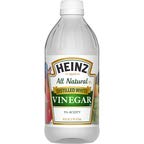 Vinegar has hundreds of household uses, including many in your laundry room! You can use it to make clothes more color-fast, but you can also use it to fade clothes in some conditions.
Vinegar has hundreds of household uses, including many in your laundry room! You can use it to make clothes more color-fast, but you can also use it to fade clothes in some conditions.
Vinegar contains something called acetic acid, which can break down and remove many stains from clothing. These include red dye, fruit juice stains, and even sweat stains!
In some cases, using a vinegar wash will perk up colored clothing dulled from using cheap laundry detergent. That said, modern clothing does not always react well to vinegar.
This is because acetic acid can also impact some dyes or fabrics. You can find out whether or not vinegar will remove dye from your clothing quite easily–simply dip an inconspicuous corner f the clothing into straight white vinegar and let it soak for ten minutes.
Do you see a circle of faded color in the fabric? If so, you can soak your clothing in a bath containing water and two cups of white vinegar for several hours. This simple process might give you the results you want!
If vinegar on its own does not touch the dye, try this method to create a darkened, vintage hue to your clothes:
- To fade clothes using vinegar, set up a wide, shallow basin filled with water. Drape five to ten teabags over the side so that the bags rest beneath the water.
- Submerge your garment and let it soak for at least two hours and up to two days.
- When you see that the fabric looks darker, remove the garment and let it air dry.
- Rinse out the shallow basin or tub and fill it with a solution of one-third vinegar to two-thirds water.
- Soak the garment in that solution for at least four hours or as long as overnight.
- Rinse it under running water and allow it to air dry.
The teabags give most fabric, even colored fabric, a duller, more vintage sheen. Then the vinegar helps to fade and set the tea color.
As a pro tip, you can also use very fine sandpaper to gently dull screen printed designs on things like t-shirts and hoodies if you want a rough and vintage vibe!
6. Lemon Juice
 Lemon juice contains citric acid, which acts like bleach on many types of clothing! This all-natural alternative to strong chemicals often shows excellent results on cotton and polyester that you want to fade.
Lemon juice contains citric acid, which acts like bleach on many types of clothing! This all-natural alternative to strong chemicals often shows excellent results on cotton and polyester that you want to fade.
- Fill a bucket with one part lemon juice to three parts water. You can use store-bought lemon juice that comes in a bottle for the easiest process!
- Submerge your garment into this solution.
- Let it soak for at least twelve hours, though you should keep an eye on it to make sure it does not get too faded.
- Finally, take it outside to dry! If possible, hang up the garment in direct sunlight to finalize the fading process.
7. Salt
You can get dramatic fading from using a salt bath on your clothing as well.
Salt in your regular laundry can help remove sweat stains. You can also use salt as a special treatment on tricky ink stains and in boiling water to brighten old linens!
For fading purposes, though, the thing to remember is that salt acts as an abrasive agent and can create a cool vintage look on many types of fabric.
- Fill up a large bucket with a gallon of water, a cup of baking soda, and four cups of iodized salt. You can also try sea salt for added friction on your garment, especially if you want to rub at a printed design on the material.
- Submerge your garment in this solution.
- Let the clothing soak for up to three days, depending on how much fading your want to see. You will need to give the mixture a vigorous stir every few hours to add friction to the process.
- Instead of rinsing out the garment, wash it in your washing machine following the manufacturer’s care label instructions. This should finalize and set the faded color.
- The final wash also makes a big difference because you do not want salt stains in your nicely faded garment!
How to Fade Clothes With Bleach
 The quickest way to fade clothes is to apply bleach. You can do this in several different ways.
The quickest way to fade clothes is to apply bleach. You can do this in several different ways.
The simplest way to bleach your clothing is to add one cup of bleach to a cold water washing machine cycle. This dilutes the bleach and may not cause dramatic results, but it will fade the clothing evenly.
The most popular method for bleaching clothes gives super dramatic results and lets you control exactly where to apply the most fading.
You should wear plastic gloves and protective glasses while using bleach to avoid damaging your eyes or skin.
- Fill a clean spray bottle with a ratio of one-fourth bleach to three-fourths water. Shake it up a bit.
- Next, soak the garment and then wring it out so that it feels nice and damp.
- Spread out a trash bag or plastic tablecloth in a sunny area outside.
- Arrange your damp garment on top of the plastic.
- Use the spray bottle to spritz bleach over the garment. You have control over how much bleach you want to apply. You can more heavily spray certain areas if you want a specific section to look more faded.
- Let the garment sit for an hour and then check the fading progress. If it looks good, take it inside and wash it according to the manufacturer’s instructions.
- If you want to see more fading, allow the clothing to finish drying in the sun.
How to Fade a Black T-Shirt
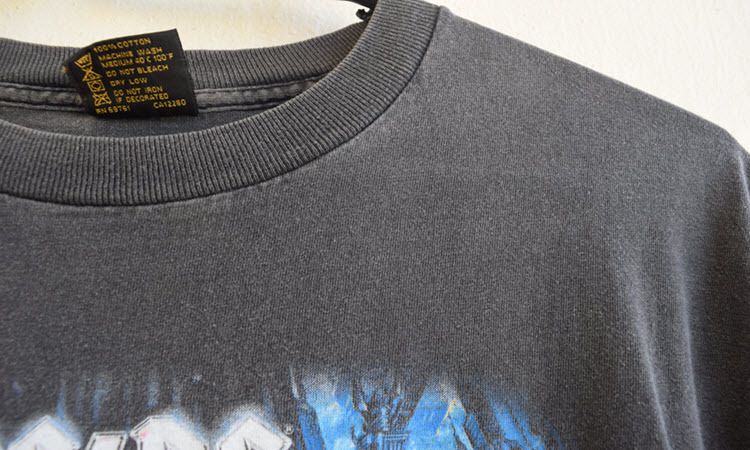
The best way to fade a black t-shirt is to use the lemon juice method. This often proves highly effective at fading a black shirt without turning it dingy or grey.
You can also try bleach, but this might remove too much color and leave you with a grey garment. The safest way to bleach a black tee is to add a quarter cup of bleach to your washing machine and repeat that process four or more times.
The sunlight method will work on black clothing, given enough time. You should do this during the summer with long, bright days to get the best results!
That said, the vinegar and teabag process won’t have a big impact on black clothes, so save that for brighter colors!
How to Fade Bright Clothes
The quickest way to fade bright clothes is to add chlorine bleach to the washing machine. For more gentle results, try the sunlight method! This gives even very bright clothes a softer, more vintage hue.
To use chlorine bleach in your washing machine:
- Set your washing machine to a hot water soak.
- Add a cup of chlorinated bleach to the hot water.
- Add your garment and let it soak for one hour.
- Finally, drain the rinse water and run a regular wash to get rid of the bleach and the bleach odor.
How to Fade Clothes in a Vintage Style
You can use any methods described in this article to give your clothes a vintage fade, including the all-natural sunlight fade and the super-quick bleach fade.
Bleach probably serves as the most popular fading method for all types of clothing because it works so fast. However, sunlight or lemon juice gives you a softer, more authentic fade.
If you have a lighter-colored garment, you may find that the vinegar and teabag technique gives you a cool grunge look.
Finally, you can follow up your fading method of choice with fun distressing techniques if you want to go whole-hog on your vintage style! You can use sandpaper to rough up printed designs or denim. You can even rip or tear portions of your clothes to make them look truly aged!
Conclusion
You can fade clothes without bleach using seven different methods, including hot water washes in your washing machine or placing the garment in your dryer. You can also apply household products like lemon juice, baking soda, vinegar and teabags, or salt. Drying your clothing in direct sunlight creates a vintage-style all-natural fade as well.
Bleaching clothing causes the quickest fade. You can do this using a bleach soak in your washing machine or by using a spray bottle and drying in the sun.
What kind of clothing do you want to fade? What process will you try? Leave a comment below to let us know!